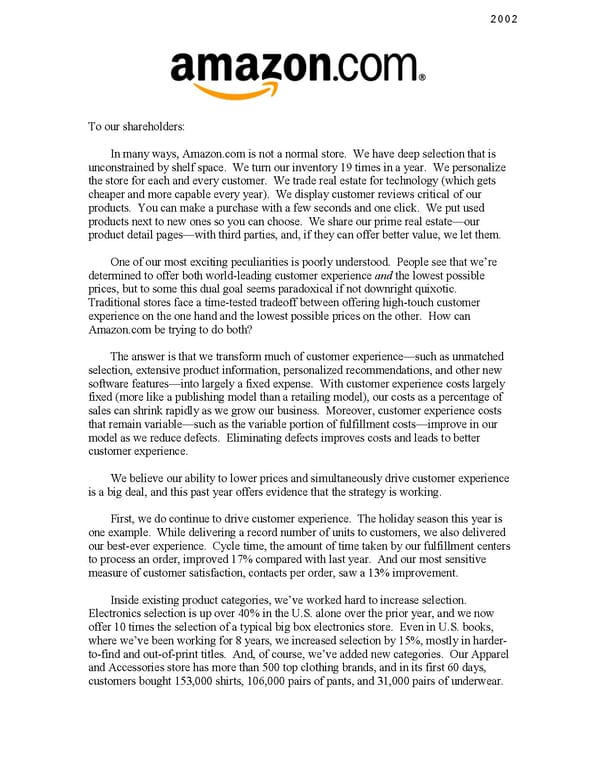2002 To our shareholders: In many ways, Amazon.com is not a normal store. We have deep selection that is unconstrained by shelf space. We turn our inventory 19 times in a year. We personalize the store for each and every customer. We trade real estate for technology (which gets cheaper and more capable every year). We display customer reviews critical of our products. You can make a purchase with a few seconds and one click. We put used products next to new ones so you can choose. We share our prime real estate—our product detail pages—with third parties, and, if they can offer better value, we let them. One of our most exciting peculiarities is poorly understood. People see that we’re determined to offer both world-leading customer experience and the lowest possible prices, but to some this dual goal seems paradoxical if not downright quixotic. Traditional stores face a time-tested tradeoff between offering high-touch customer experience on the one hand and the lowest possible prices on the other. How can Amazon.com be trying to do both? The answer is that we transform much of customer experience—such as unmatched selection, extensive product information, personalized recommendations, and other new software features—into largely a fixed expense. With customer experience costs largely fixed (more like a publishing model than a retailing model), our costs as a percentage of sales can shrink rapidly as we grow our business. Moreover, customer experience costs that remain variable—such as the variable portion of fulfillment costs—improve in our model as we reduce defects. Eliminating defects improves costs and leads to better customer experience. We believe our ability to lower prices and simultaneously drive customer experience is a big deal, and this past year offers evidence that the strategy is working. First, we do continue to drive customer experience. The holiday season this year is one example. While delivering a record number of units to customers, we also delivered our best-ever experience. Cycle time, the amount of time taken by our fulfillment centers to process an order, improved 17% compared with last year. And our most sensitive measure of customer satisfaction, contacts per order, saw a 13% improvement. Inside existing product categories, we’ve worked hard to increase selection. Electronics selection is up over 40% in the U.S. alone over the prior year, and we now offer 10 times the selection of a typical big box electronics store. Even in U.S. books, where we’ve been working for 8 years, we increased selection by 15%, mostly in harder- to-find and out-of-print titles. And, of course, we’ve added new categories. Our Apparel and Accessories store has more than 500 top clothing brands, and in its first 60 days, customers bought 153,000 shirts, 106,000 pairs of pants, and 31,000 pairs of underwear.
 Amazon Shareholder Letters 1997-2020 Page 26 Page 28
Amazon Shareholder Letters 1997-2020 Page 26 Page 28